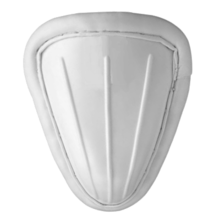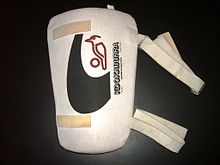- Cricket clothing and equipment
-
Cricket is traced back to 1550. It was first played in Guildford, Surrey. Later in 1598, cricket was cited in an Italian English dictionary written by Florio. In the year 1676, British residents in Aleppo played cricket abroad for the first time.
In cricket a wide range of equipment is required. Cricket clothing is slightly loose fitting so that it is comfortable.
Contents
Equipment
- Ball – A red or white ball with a cork base, wrapped in twine covered with leather. The ball should have a circumference of 23 cm (9 inches) unless it is a children's size.
- Bat – A wooden bat is used. The wood used is from the Kashmir or English willow tree. The bat cannot be more than 38 inches (96.5 cm) long and 4.25 inches wide (10.8 cm). Aluminium bats are not allowed. The bat has a long handle and one side has a smooth face.
- Stumps – 3 wooden poles known as the stumps.
- Bails – Two crosspieces are known as the bails
- Sight screen – A screen placed at the boundary known as the sight screen. This is aligned exactly parallel to the width of the pitch and behind both pairs of wickets.
- Boundary – A rope demarcating the perimeter of the field known as the boundary.
Clothing and protective wear
- A polo shirt which is worn by everyone in the match (T-shirt with collar)
- Long trousers (often white, but stained red in parts from polishing the ball)
- Jumper (a woollen pullover, if necessary)
- Jockstrap into which a "cup" is inserted and held in place
- Abdomen guard or "cup" for male batsmen and wicket-keepers (often referred to as a cup, box or abdo guard). It is usually constructed from high density plastic with a padded edge, shaped like a hollow half-pear, and inserted into the jockstrap of the batsmen and wicket-keeper. This is used to protect the testicles against impact from the ball
- Sun hats, cricket cap or baseball cap
- Spiked shoes to increase traction
- Helmet (often with a visor), worn by batsmen and fielders close to the batsman on strike.
- Leg pads, worn by the two batsmen and the wicket-keeper, used to protect the shin bone against impact from the ball, fielders that are fielding in close to the batsmen may wear shin guards as well.
- Thigh guard, arm guards, chest guard, and elbow guards to protect the body of the batsmen.
- Gloves for batsmen only, thickly padded above the fingers to protect against impact from the ball as it is bowled
- Wicket keeper's gloves for the wicket-keeper which are larger and look like mitts. Usually includes webbing between the thumb and index fingers.
Batsmen are allowed to wear gloves while batting. The batsman can be also caught out if the ball touches the glove instead of the bat, provided the hand is in contact with the bat. This is because the glove is considered to be the extension of the bat. The batsman may also wear protective helmets usually with a visor to protect themselves. Helmets are usually employed when facing fast bowlers. While playing spinners, it might not be employed.
Fielders cannot use gloves to field the ball. If they wilfully use any part of their clothing to field the ball they may be penalised 5 penalty runs to the opposition. If the fielders are fielding close to the batsman, they are allowed to use helmets and leg guards worn under their clothing.
The wicketkeeper, due to being directly behind the batsman and therefore having the ball bowled directly at him is allowed to wear leg guards, a helmet, a light internal glove and a large external glove like a mitt.
See also
References
Cricket clothing and equipment Equipments Clothing Others Cricket nets • Snickometer • Hawk-Eye • Hot Spot • Category:Cricket equipment
Categories:- Cricket equipment
- Sports clothing
- Cricket
Wikimedia Foundation. 2010.



